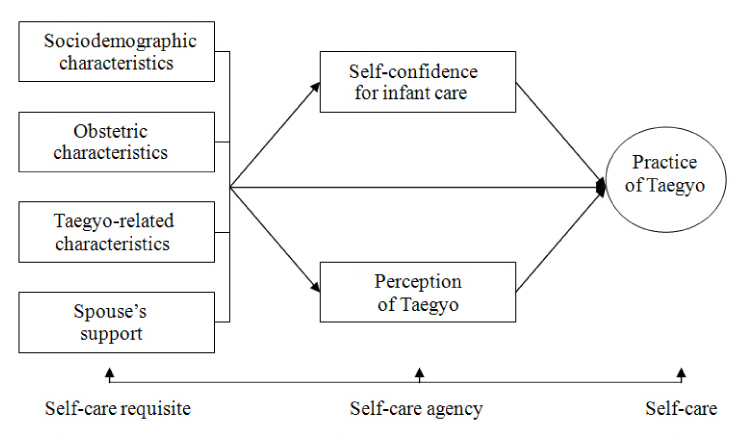Korean J Women Health Nurs.
2011 Dec;17(5):491-498. 10.4069/kjwhn.2011.17.5.491.
Factors Associated with the Practice of Traditional Prenatal Education (Taegyo) among Pregnant Korean Women
- Affiliations
-
- 1Department of Nursing, College of Medicine, University of Dongguk, Korea. yhkim@dongguk.ac.kr
- KMID: 2308240
- DOI: http://doi.org/10.4069/kjwhn.2011.17.5.491
Abstract
- PURPOSE
Recently as couples have only one or two children, they concern about their children's optimal health. Furthermore, as the basic principles of Korean traditional prenatal education (Taegyo) are supported by scientific evidence, and as increasing numbers of pregnant women are recognizing Taegyo refresh, the practice of Taegyo is growing. The purpose of this study was to identify the factors associated with the practice of Taegyo among pregnant Korean women.
METHODS
This was a cross-sectional, survey study of 228 pregnant women recruited at a health center in South Korea using a convenience sampling method. The instruments included the perception of Taegyo scale, the spouse's support scale, the self-confidence for infant care scale, and the practice of Taegyo scale. The data were analyzed using descriptive statistics and multiple regression analyses.
RESULTS
The results of the stepwise multiple regression analysis indicated that the following factors accounted for 26.5% of the variance in the practice of Taegyo: the perception of Taegyo, family income.
CONCLUSION
Consequently, this result showed that the pregnant women were influenced by family income, spouses' support as requisite factors, and also they developed the level of self-confidence for infant care and the perception of Taegyo as self-care agency for the practice of Taegyo. The present study findings will add to the accumulated knowledge of health care professionals about the cultural factors involved in the practice of Taegyo and the traditional cultural beliefs and culture-specific health promoting behaviors of ethnic minority pregnant women to provide culturally competent care for them.
Keyword
MeSH Terms
Figure
Reference
-
1. Ahn K.J. A study of related factors and practise of Taegyo on pregnant women. 2001. Seoul: Ewha Womans University;Unpublished master's thesis.2. Campbell J.C., Weber N. An empirical test of a self-care model of women's responses to battering. Nursing Science Quarterly. 2000. 13(1):45–53.3. Chang S.B., Park S., Chung C.W. Effect of Taegyo-focused prenatal education on maternal-fetal attachment and self-efficacy related to childbirth. Journal of Korean Academy of Nursing. 2004. 34(8):1409–1415.4. Chang S.B., Park Y.J., Choi Y.S., Chung C.W. Factors of the "Taegyo" of Korean pregnant women: Self care of pregnant women based on oriental folk behavior. The Journal of Nurses Academic Society. 1996. 26(2):345–358.5. Cho D.S. A study on the Taegyo behavior of women who had given birth and the health professionals perception of Taegyo. 1987. Seoul: Yonsei University;Unpublished doctoral dissertation.6. Choi E.C. Unique aspects of Korean-American mothers. Journal of Obstetric, Gynecologic, and Neonatal Nursing. 1986. 15:394–400.7. Choi Y.S., Kim H.O. A Survey on the practice Taegyo among childbearing couples. Korean Journal of Women Health Nursing. 1995. 1(2):153–173.8. Croghan E. An introduction to behavior change among clients. Nursing Standard. 2005. 19(30):60–62.9. Cohen J. Statistical power analysis for the behavioral sciences. 1988. 2nd ed. Hillsdale, NJ: Lawrence Erlbaum.10. Denyes M.J., Orem D.E., SozWiss G.B. Self-care: A foundational science. Nursing Science Quarterly. 2001. 14(1):48–54.11. Hart M.A. Nursing implications of self-care in pregnancy. American Journal of Maternal Child Nursing. 1996. 21(3):137–143.12. Ho I., Holroyd E. Chinese women's perceptions of the effectiveness of antenatal education in the preparation for motherhood. Journal of Advanced Nursing. 2002. 38(1):74–85.13. Kim H.O. An ethnographic study about Taegyo practice in Korea. 1996. Seoul: Yonsei University;Unpublished doctoral dissertation.14. Total fertility rate, Preliminary Results of Birth Statistics in 2005. Korea National Statistical Office. 2006. Retrieved May 23. from http://kostat.go.kr.15. Low birthrate. Kuki News. 2006. Retrieved May 23, 2006. from http://kuki.stoo.com.16. Lee J.H. The effect of a childcare education for first-time mothers on newborn care behavior and confidence in maternal role. Korean Journal of Women Health Nursing. 1998. 4(3):322–331.17. Lee S.S., Shin I.C., Jo N.H., Kim H.K., Jung Y.S., Choi E.Y., et al. Study on causes and policies for low fertility. 2005. Seoul: Korea Institute for Health and Social Affairs.18. Orem D.E. Nursing concepts of practice. 2001. 6th ed. St. Louis, Missouri: Mosby.19. Park M.S. Comparative study on self-confidence for infant care of primiparas between rooming-in and not rooming-in. 1991. Seoul, Korea: Korea University;Unpublished master's thesis.20. Pearson A., Vaughan B., Fitzgerald M. Nursing models for practice. 2005. 3rd ed. Philadelphia: Elsevier Limited.21. Pritham U.A., Sammons L.N. Korean women's attitudes toward pregnancy and prenatal care. Health Care for Women International. 1993. 14(2):145–153.22. Shin Y.B. A study on the perception and the practice of Taegyo by pregnant women. 2000. Daegu, Korea: Keimyung University;Unpublished master's thesis.23. Shin Y.B., Ko H.J. A study on Recognition and practice of Taegyo by pregnant women. Korean Journal of Women Health Nursing. 2000. 6(1):142–152.24. Slusher I.L. Self-care agency and self-care practice of adolescents. Issues in Comprehensive Pediatric Nursing. 1999. 22:49–58.25. Toljamo M., Hentinen M. Adherence to self-care and social support. Journal of Clinical Nursing. 2001. 10:618–627.26. Villar J., Bergsjo P., Carroli G., Gulmezoglu M. Letter to the editor-The WHO new antenatal care model: The way forward. Acta Obstetricia et Gynecologica Scandinavica. 2003. 82:1065–1066.27. Wilson F.L., Mood D.W., Risk J., Kershaw T. Evaluation of education materials using Orem's self-care deficit theory. Nursing Science Quarterly. 2003. 16(1):68–76.28. "Well-born" trend. Yonhop News. 2005. Retrieved Nov 18, 2005. from http://www.yonhapnews.
- Full Text Links
- Actions
-
Cited
- CITED
-
- Close
- Share
- Similar articles
-
- Correlations among Perceptions and Practice of Taegyo and Maternal-Fetal Attachment in Pregnant Women
- Is It Possible to Prove the Effect of Prenatal Education, 'Taegyo'?
- Impact of Anxiety, Social Support, and Taegyo Practice on Maternal-Fetal Attachment in Pregnant Women Having an Abortion
- The Contribution of Maternal-Fetal Attachment: Taegyo, Maternal Fatigue and Social Support during Pregnancy
- Factors of the 'Taegyo' of Korean Pregnant Women: Self Care of Pregnant Women Based on Oriental Folk Behavior


